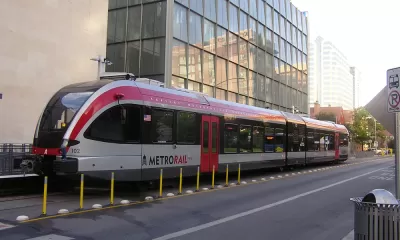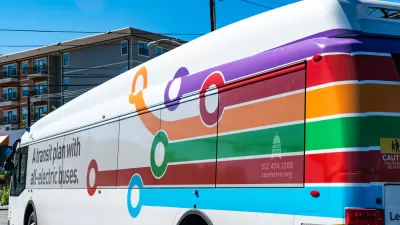The public got its first taste of the ambitions of the Project Connect transit plan in the state capital of Texas.

"After months of speculation and rumors, officials Tuesday offered a glimpse at a massive transportation plan — which includes a downtown subway — aimed to usher in a new generation of transit for a growing city," reports Alyssa Gourd.
It was the first time potential details of the Project Connect transit plan were made public, according to Gourd.
The plan is currently under development by the Austin City Council and Capital Metro Board. "The transit plans these groups are looking at range from $3.2-$10.2 billion, depending on the features they select," according to Gourd. "CapMetro explained they believe they can pay for 40% of this amount through federal grants." A public vote is one option for the remainder of funding.
A separate article by Paul Livengood and Hank Cavagnaro summarizes the scope of Project Connect, at this early point in the planning process, thusly: "Capital Metro announced its Project Connect transit system on Tuesday, which includes more MetroRail options and the construction of an underground tunnel housing a light rail system in the Downtown Austin area."
"The tunnel is a portion of one of two proposed transitways designed to alleviate downtown traffic and prevent cars from getting stuck behind a transit vehicle, according to city documents," according to Livengood and Cavagnaro.
The Project Connect website lists four primary visions for the plan: transitways, better bus service, improved commuter rail, and new transit centers.
Planetizen first picked up news about Austin's intentions to complete a big, ambitious transit plan in November 2019.
FULL STORY: A subway in Austin? City leaders explore massive transit expansion

Study: Maui’s Plan to Convert Vacation Rentals to Long-Term Housing Could Cause Nearly $1 Billion Economic Loss
The plan would reduce visitor accommodation by 25,% resulting in 1,900 jobs lost.

North Texas Transit Leaders Tout Benefits of TOD for Growing Region
At a summit focused on transit-oriented development, policymakers discussed how North Texas’ expanded light rail system can serve as a tool for economic growth.

Why Should We Subsidize Public Transportation?
Many public transit agencies face financial stress due to rising costs, declining fare revenue, and declining subsidies. Transit advocates must provide a strong business case for increasing public transit funding.

Alabama: Trump Terminates Settlements for Black Communities Harmed By Raw Sewage
Trump deemed the landmark civil rights agreement “illegal DEI and environmental justice policy.”

Dear Tesla Driver: “It’s not You, It’s Him.”
Amidst a booming bumper sticker industry, one writer offers solace to those asking, “Does this car make me look fascist?”

A Visual Celebration of Manhattan’s Chinatown Elder Community, Through Food
Lanterns, cafeteria trays, and community connection take center stage in this stunning photo essay.
Urban Design for Planners 1: Software Tools
This six-course series explores essential urban design concepts using open source software and equips planners with the tools they need to participate fully in the urban design process.
Planning for Universal Design
Learn the tools for implementing Universal Design in planning regulations.
City of Santa Clarita
Ascent Environmental
Institute for Housing and Urban Development Studies (IHS)
City of Grandview
Harvard GSD Executive Education
Toledo-Lucas County Plan Commissions
Salt Lake City
NYU Wagner Graduate School of Public Service




























